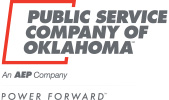When demand for energy is high, like during summer’s hottest days, PSO calls on its team of Peak Performers to help. You decide how to reduce your energy usage, and then PSO pays you based on how much energy you saved.
When we work together, we can keep electricity costs stable and ensure the reliability of electrical grid. The tips below help you reduce the load during a peak event.
1. Dim some lights.
Check all of these areas:
- Hallway of corridor lighting
- Stairwell lighting
- Outdoor lighting, signage, window displays and decorative lighting
- Public space lighting (meeting rooms, lobby, etc.)
- Merchandise display lighting
- Overhead lighting (use task lighting at workstations where available)
2. Pre-cool the building.
When notified of a peak event, adjust the temperature setting on your thermostat so that it is 2-4 degrees cooler than typical. Then, raise the temperature 2-4 degrees higher than typical when the peak event begins.
For example, if your thermostat is typically set at 70 degrees, turn it down to 66 degrees immediately upon receipt of notice of peak event. At 2 p.m., when a peak event starts, raise your thermostat setting to 74 degrees. The pre-cooling accomplished previously will keep the building comfortably cool throughout the peak event.
Also use window shades where available.
3. Cycle air-cooled package units and/or constant volume air handlers.
4. Reduce fan speed on variable volume air handlers.
5. End re-heat draw-through units.
Some cooling systems use re-heat coils to provide individual room comfort by reheating the air just before it is supplied to a room or office. These are not energy-efficient units.
There is a huge potential for permanent savings if these re-heat coils are removed.
6. Unplug small kitchen appliances.
Including microwave ovens, coffee makers or ice machines.
7. Unplug small space heaters.
8. Unplug non-essential office machines.
Think paper shredders and unused workstations.
9. Unplug vending machines.
Snack time can wait.
10. Postpone charging batteries.
Cars, fork lifts, cellphones, tablets or other equipment with plug-in battery chargers can be recharged later.
